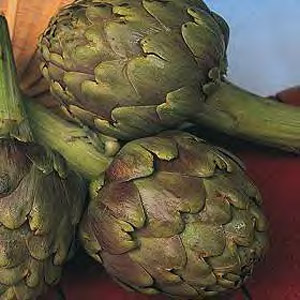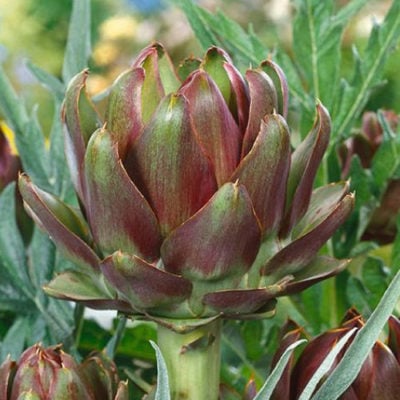
Learning Download: How to Grow Artichokes
From Seed to Harvest: A beginner’s guide to growing artichokes
Seeing the large globe of an artichoke and imagining growing the edible beast in a garden may seem intimidating, but artichokes can be an easy and striking addition with the ability to grow almost anywhere in the United States. Depending on climate, some artichoke plants may return as perennials.
To plant:
Artichoke seeds can be started in February in a greenhouse or under a fluorescent light, planted about 1/4-inch deep in 4-inch containers. Artichokes are known as tap-rooted plants, which means their roots grow deep, even as seedlings. Be sure to plant the seeds in a deep container. Transport seedlings to the garden 8 to 10 weeks later, but be sure the danger of frost has passed. By then, the transplant should be nearing 10 inches in height. Plant the seedlings four feet or more apart as the plants grow large. Before planting in the garden, add compost to the soil.
Artichokes require vernalization, which is a process where the plant experiences cooler temperatures such as below 50 degrees, for a few weeks, in order to accelerate flowering. However, the plant is frost sensitive, so plant after frost dates but before spring temperatures rise.
To grow:
Artichokes require nutrient-rich soil, so be sure to fertilize with fish emulsion. Artichokes can reach a height of five to six feet tall and up to five feet wide, so be sure there is plenty of space for the plant to grow. Often times, artichokes do nit grow true to their seed name, and gardeners will have better luck purchasing artichoke seed rather than harvesting from their own plant. Keep the artichoke bed free of weeds and add a multi-inch layer of mulch around the plants to reduce weed growth. Not many animals eat artichoke plants, though beware of slugs and aphids.
To harvest:
Harvest buds measuring at least three inches across while the bud is still closed. The more a bud opens, it becomes bitter, and fully open buds are inedible. To harvest, cut a couple of inches of the bud’s stem to easily handle the bud. lower buds won’t grow as large as the top ones. When all buds have been harvested, cut the entire plant back by a third to encourage future growth. Store artichokes in the refrigerator.
What an artichoke craves:
Artichoke plants thrive and set their best buds in full sun, but in warmer climates, the plant can tolerate partial shade. Artichokes grow best in a soil pH of 6.0 to 7.0. Artichokes require well-drained soil, as well as soil with a good amount of organic matter. If garden soil is of poor quality, plant the artichokes in raised beds.
Where to buy artichoke seeds:
You can find different varietals of artichoke seeds at Urban Farmer.
Learning Download: Common pests and diseases: Artichokes
Common pests and diseases: Artichokes
When growing vegetables, it is always exciting to care for the plant throughout its growing phase and then harvest it for delicious recipes later on, but one thing to watch out for is pests and diseases. Different plants are susceptible to different types of pests and diseases, and it is important to make yourself aware so you can keep a watchful eye and also take any preventative methods to keep your plants safe throughout their lifespan.
Artichokes can fall victim to several different pest and diseases.
Pests
Some of the organisms that can harm an artichoke plant include sucking insects, such as aphids, mites, scabs and thrips. These pests not only aid in transmitting diseases that can harm an artichoke plant, they also slow down the rate at which the plant grows.
Other insects, such as chewing insects like leafhoppers, moths, cutworms, armyworms and larvae can harm the artichoke plant by damaging the leaves, worsen the aesthetic appeal of the plant and even kill the plant’s foliage if let get out of control.
There are several ways to prevent and rid these pests from your artichoke plants. The first step is the check the plant to check if you can see any of the pests. Do not forget to check underneath the plant’s large leaves.
If you do find some of the above pests harming your artichoke plants, there are several methods you can take. First, spray the leaves of the plant in the morning with water to wash away many of the insects. Next, you can utilize a horticultural soap or a neem oil for the plants that may be experiencing a larger infestation. If you see any larvae on the plant, pick them off before they can damage it. If the infestation is truly out of control, use pesticides.
Diseases:
It is not just bugs that can harm or even kill your artichoke plants, but the artichoke plant is susceptible to several different diseases, as well. One common occurrence that happens in young plants is damping off, which is a soil-borne disease that makes the artichokes wilt and then die.
Powdery mildew and Botrytis fungus are tow common diseases affecting the artichoke plant. The powdery mildew will create a white coating on the leaves and the Botrytis fungus will cause the plant to collapse.
Diseases are a bit tougher to stop once they occur, but prevention is the gardener’s best friend when it comes to keeping diseases away. Utilize crop rotation so the same type of crops aren’t growing in the same area year after year. Another common mistake made by gardeners is overhead watering, and by avoiding this, you may be able to avoid many different types of diseases, especially those caused by fungus.


